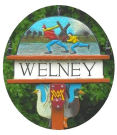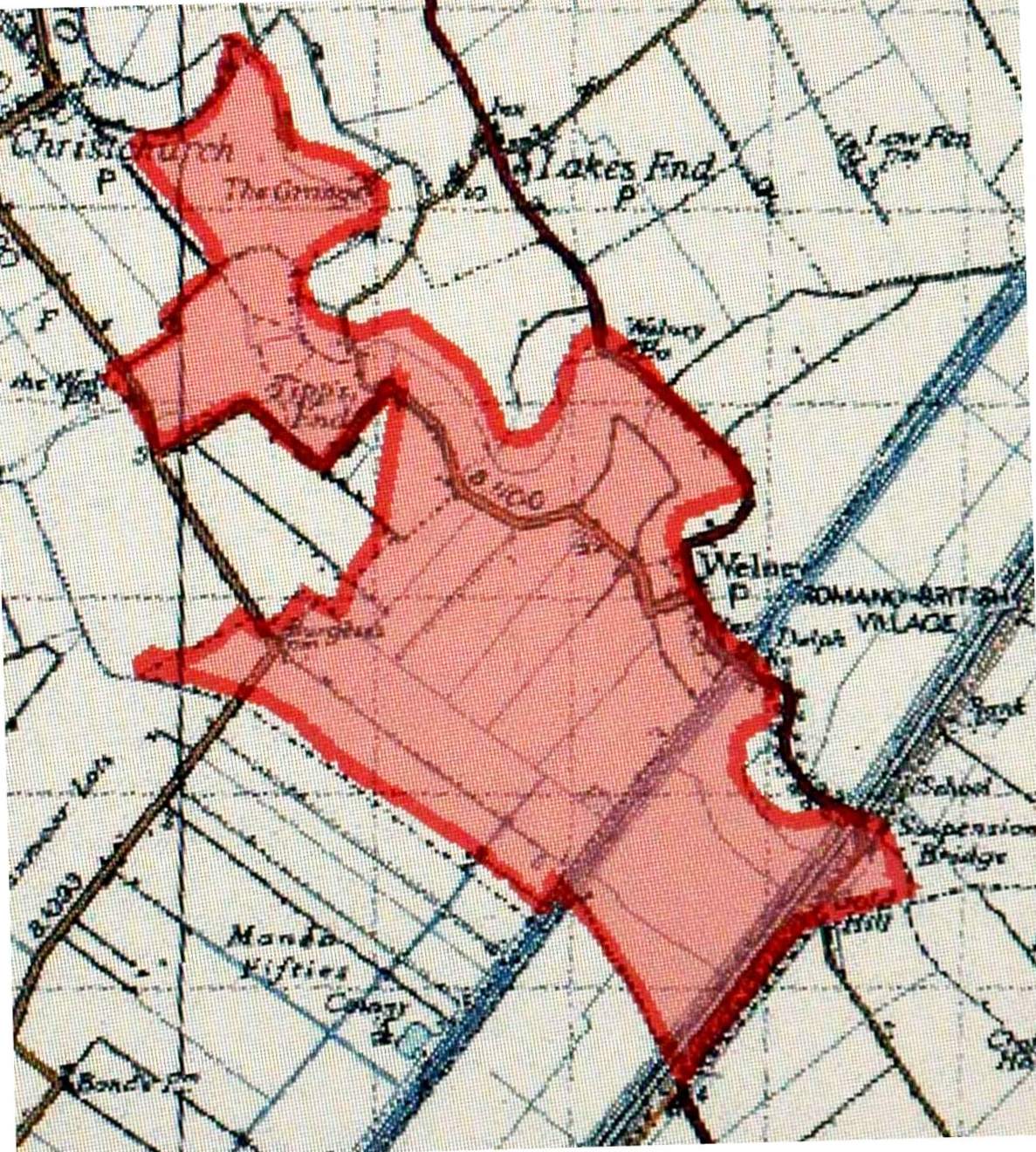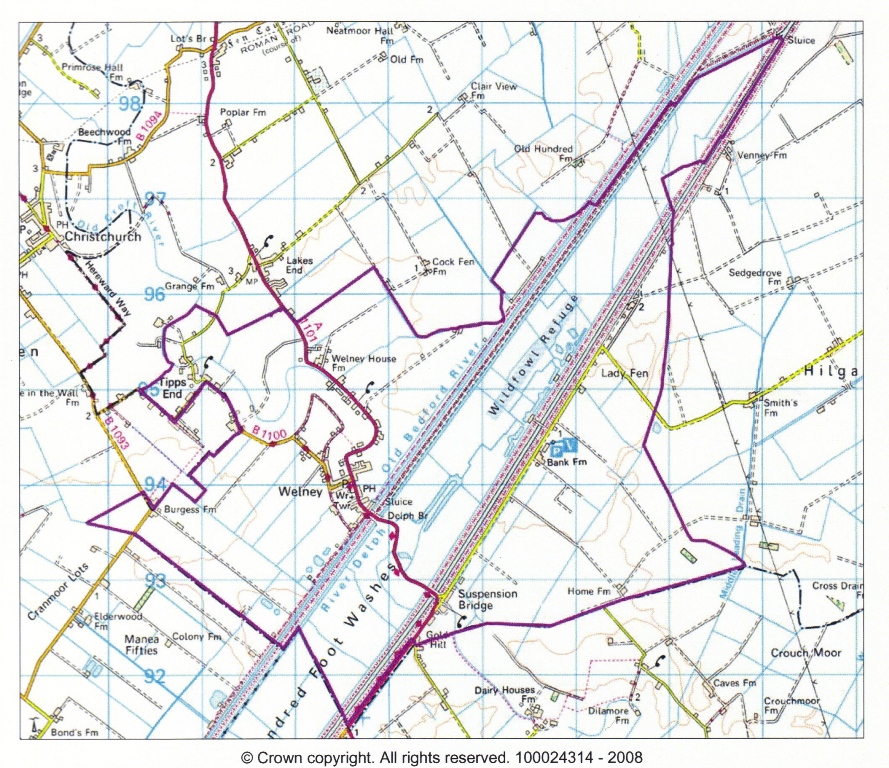
|
The Welney WebsiteWelney Parish Historypage created Aug 2010, last updated Friday, 21 June 2019 |

|
Introduction
Many people don't realise or fully appreciate that there are two sorts of Parishes - Civil and Ecclesiastical (i.e. Church). Below is a very brief "broad-brush" outline of how parishes evolved in England, in particular our Parish of Welney.Ecclesiastical (Church) Parishes
In rural England, the earliest parishes were often the "manor", i.e. the land or estate of a local Lord. It may have embraced a number of villages, hamlets or other settlements and may have been in more than one county. The Lord would probably have employed many of the population and administed the area and dispensed justice from the Manor House. Later the Church (of England) took on much of those responsibilites, and Parishes were usually named after the village in which the church was located.As populations increased, and to avoid long or difficult journeys to a parish church from remoter parts, smaller places of worship were built locally, often referred to as chapels (but not to be confused with non-conformist, e.g. Methodist or Baptist chapels). The main church of the parish was then referred to as the 'mother-church'.
Because parishes were ecclesiastical areas (i.e.controlled by the Church of England in some way or other) their boundaries were not defined or restricted by county boundaries which were, and still are, civil administrative areas. Thus Welney was once a "chapelry" within the ecclesiastical Parish of Upwell, with the Rector there administering the whole parish, and a curate in charge of the chapel at Welney.
Even after the old Welney chapel was replaced with a new and much larger building, a "proper" church, St.Mary's, in 1848 (and despite an Act of Parliament in 1846 separating Welney ecclesiastically from Upwell) it remained a curacy of Upwell until the rector, Rev WG Townley, died in 1862 when it finally became a distinct Parish for both ecclisiastical and civil purposes, with its own rectory built in 1864. (Sold in 1978, and became a home for the elderly).
Civil Parishes
For civil administration, one reference (Genuki, Downham Registration District) states that Welney was split from Upwell in 1837. As the ecclesiastical Parish straddled the county boundary between Norfolk and Cambridgeshire which followed the course of Old Croft River, two civil parishes had to be formed - 'Welney (Norfolk)' and 'Welney (Cambs)'.That statement conflicts with the fact that in 1894/95 the UK parliament re-organised local government, creating civil parishes distinct from ecclesiastical ones, administered by elected parish councils. In Welney, the ecclesiastical parish remained as it was, controlled by a parochial church committee, but the area it covered was divided into two civil parishes, the part that had been in Cambridgeshire being named West Welney, and transferred to Norfolk.
In Welney village, lands and buildings on the west side of Main street were in the Isle of Ely division of Cambridgeshire, whilst the road itself and everything to the east was in Norfolk.
In 1889 The Isle of Ely became a separate administrative county (remaining so until 1965 when it merged back into Cambridgeshire). Also in 1889 the parish of Welney (Cambs) was transferred into Norfolk, and a just few years later, in 1895, was renamed 'West Welney'. (Logically, the name change should have occurred when the area changed Counties). in 1935, Welney and West Welney, were combined.
Records in 1854 put the total area as 5,500 acres. In 1869 it was recorded as 5,288, in 1881 as 5287, 1883 & 1892 as 5,444.
In In 1884 a detached part of Upwell [about 65 acres?] was amalgamated into Welney.
(Is that correct?)
Chronology
| year | mth | ref | |
| 1834 | Poor Law Act withdrew much of poor law admin from parochial authorities | ||
| 1844 | Poor Law Amendment Act | ||
| 1854 | R. G. Townley's manor of Beaupre Hall, and in the Bishop of Ely's manor of the Isle of Ely. | ||
| 1846 | |||
| 1848 | new church in Welney replaced previous chapel | ||
| 1849 | Inclosure Act | ||
| 1868 | church tithe rate abolished. parish admin reduced to barest legal minimum | ||
| 1884 | detached part of Upwell, 65 acres, transferred to Welney | 14 | |
| 1889 | The Isle of Ely split from Cambs and gained county status | ||
| 1889 | civil parish of Welney (Cambs) transferred to Norfolk | ? | |
| 1894 | Civil Parishes created as tier of local government to toke over civil functions from existing parochial authority which had largely been the Squire, Schoolmaster and Parson, ie those with superior education, wealth & social standing. Governed by an elected Parish Council, | 1 | |
| 1894 | Dec | ||
| Welney (Cambs) became West Welney (Norfolk) | |||
| 1935 | civil parish of West Welney merged into Welney | ||
| 1965 | The Isle of Ely lost county status and merged with Cambs | ||
| ref | year | Act, Directory or source of info | abbr |
| 14 | 1882 | Divided Parishes and Poor Law Amendment Act | DP&PLAA |
| 1 | 1894 | Local Government Act | LGA |
| 2 | 1854 | Whites Directory | |
Size and population
| year | Welney Norfolk | (West) Welney Cambs | Welney Totals |
| acres | pop | ref | acres | pop | ref | acres | pop'n | |
| 1841 | 1900 | 405 | ||||||
| 1854 | 3600 | 647 | WD | 1900 | 559 | WD | 5500 | 1206 |
| 1861 | 624 | 477 | 1101 | |||||
| 1869 | 5288 | |||||||
| 1871 | ||||||||
| 1881 | 3527 | 527 | 1760 | 499 | 5287 | 1026 | ||
| 1892 | 593 | KDC | 486 | KDC | 5444 | 1079 | ||
| 1896 | 3453 land & 74 water |
514 | KDN | 1806 L & 19 W |
565 | KDN | 5259 land & 93 water 5352 tot |
1079 |
| 1901 | 488 | 453 | 941 | |||||
| 1911 | 449 | 559 | 1008 | |||||
| 1921 | 3453 land & 74 water |
366 | 1806 L & 22 water |
531 | 5259 land & 96 water 5355 tot |
897 | ||
| 1931 | 3485 | 1817 | 5302 | |||||
| 1935 | The two civil parishes combined | |||||||
| 1951 | 5062 | 734 | ||||||
| 1961 | 5062 | 601 | ||||||
| 1971 | ||||||||
| 1981 | ||||||||
| 1991 | ||||||||
| 2001 | 5080 | 510 | ||||||
| 2011 | ||||||||
| ref | source |
| population and area are Census figures quoted as below | |
| KDN | Kellys Directory of Norfolk |
| KDC | Kellys Directory of Cambridgshire |
| WD | Whites Directory |
| F Youngs, Local Administrative Units, Southen England, 1979** |
** "This work is based on data provided through www.VisionofBritain.org.uk and uses historical material which is copyright of the Great Britain Historical GIS Project and the University of Portsmouth".

West Welney CP, 1895-1935
note changes on 2010 map
Parish boundary maps

Welney CP boundary, 2010
Francis White's History, Gazetteer and Directory of Norfolk 1854, pp. 644-5
Complete entry. Transcription Copyright © A.J. Carter, February, 2001WELNEY is a village and considerable parish, 10 miles S.W. of Downham, lying in the cultivated fens of the Great Bedford Level, partly in Norfolk, and Cambridgeshire, and in R. G. Townley's manor of Beaupre Hall, and in the Bishop of Ely's manor of the Isle of Ely.
The parish contains 270 houses, 1,206 souls, and 5,500 acres of land, chiefly the property of R. G. Townley, Esq., P. Huddleston, Esq., and Messrs. W. Little, Jph. Clemenson, and Robt. Beart.
The fen land is frequently inundated several feet deep during the winter season. Of the above, 1,900 acres and 559 inhabitants are in Cambridgeshire, and form a separate township.
The small river which here divides the counties, is navigable to Wisbech [sic] canal ; and a little above the village is crossed by those broad drains, called the Old and New Bedford rivers : the latter is crossed by a handsome suspension bridge of great height, and 63 yards, 2 feet long, built by the Rev. W. G. Townley, in 1826.
The CHURCH is a neat structure, erected in 1848, at the cost of £5,000 ; the pulpit is of stone, neatly carved, and a beautiful stained glass window ornaments the chancel. The Rev. A. W. Roper, B.A. is curate. The living is consolidated with Upwell.
In 1661 Wm. Marshall, Esq. bequeathed nine pieces of land, comprising 466a. 36p., and directed one-third of the yearly proceeds to be applied in repairing the Church and the bridge leading to it ; one-third for relieving poor widows, and apprenticing poor children ; and the other third for repairing the highways of Welney. This estate is let annually in 18 lots to the highest bidder, and the rents now amount to between £700 and £800. The income being more than necessary for the objects named by the donor, a new scheme was approved by the Court of Chancery in 1819, and one-third of the clear income is now applied in relieving poor widows, and apprenticing and clothing poor children ; two-thirds in repairing the Church, bridge, and highways, and in supporting a Free School. The trustees erected a good school and residence for the teacher in 1848 : about 100 boys and 100 girls attend. In the same year six almshouses were built for six poor widows, each of whom receive 3s. a week
Kelly's Directory for Cambridgeshire, Norfolk & Suffolk 1883, (Cambridgeshire section), p. 122.
Complete entry. Transcription Copyright © E.C."Paddy" AplingWELNEY is a parish, situated partly in the Isle of Ely, and county of Cambridgeshire and partly in Norfolk, in the hundred of Wisbech, union and county court district of Downham, rural deanery of Fincham, archdeaconry of Norfolk and diocese of Norwich; it is on the banks of the Old Bedford river, 5 miles west from Manea station, 13 south-east from Wisbech, and 10 south-east from March.
In 1826 the Rev. William Gale Townley erected at his own expense a handsome suspension bridge across the Hundred-foot river, thus connecting the village with Littleport and Ely, which could previously only be reached by ferry.
In 1848 the old church was taken down and a new one erected and named in honor of St.Mary the Virgin: it is a handsome stone building in the Early English style; the cost was defrayed by funds furnished by Marshall's charity: it consists of chancel and nave, with a bell turret containing 2 bells and has sittings for 420: there is a handsome stained east window. The registers are amongst the oldest in the deanery, dating from the year 1642. The living, formerly a chapelry of Upwell, is now a rectory in the gift of Charles Watson Townley esq. Lord Lieutenant of Cambridgeshire, and held by the Rev. Edward Russell Wilford M.A. of Christ's College, Cambridge, who is also a surrogate in the diocese of Norwich and diocesan inspector of schools in the deanery of Fincham; a substantial rectory house was built in the year 1864. The tithe is commuted at £1,258 18s. 2d. and there are 13 acres of glebe.
The Baptists and Primitive Methodists have chapels here.
The funds of Marshall's charity are derived from lands left by W. Marshall esq.: this estate, which formerly only realised about £70 a year, has now so increased in value as to bring in a net income of about £700 a year: the property is vested in the hands of the trustees and the income is divided in the following manner; one-third is given to the widows in the parish and two-thirds are appropriated to the church, the schools and the roads.
Charles Watson Townley esq. is lord of the manor.
The principal landowners are F. R. Beart, esq., W. R. Beart, esq, Morley Beart, esq. William Little esq. James Failes esq. and Joseph Morton esq. The soil is clay and fen; subsoil clay. The chief crops are wheat, beans and roots.
The area is 5,444 acres; rateable value of Cambridge portion £3,426, and of Norfolk portion £5,920; the population, who are wholly dependent on husbandry, numbered in 1881, 499 in the Isle of Ely and 527 in Norfolk, making a total of 1,026.
TIP'S END is 2½ miles north-west, and the Wash to the south Parish Clerk, Jeremiah Jacobs.
The parish of Welney was formerly partly in the Isle of Ely (Cambs.) and partly in Norfolk.
In 1895 both parts were assigned to Norfolk but divided into two parishes, the former Cambridgeshire parish being known as West Welney.
There were some boundary changes in 1935 as a result of the County Review Order and a single parish of Welney was created.
Reference: PC 70/1 Minute book of Welney (Norfolk) parish council, Dec. 1894-Mar. 1957
Reference: PC 70/2 Minute book of West Welney (Isle of Ely) parish council, Dec. 1894-Mar. 1935